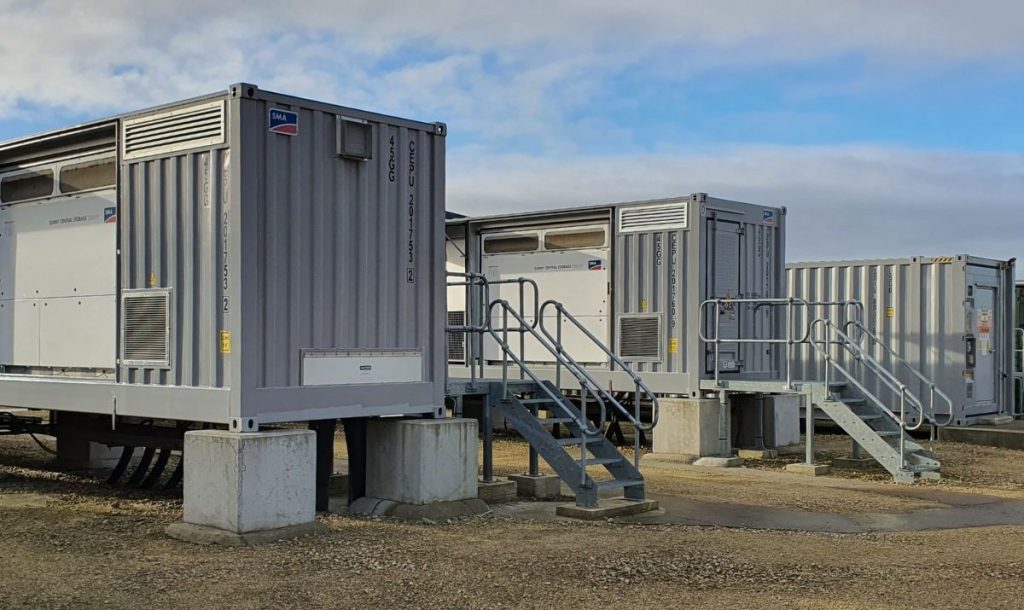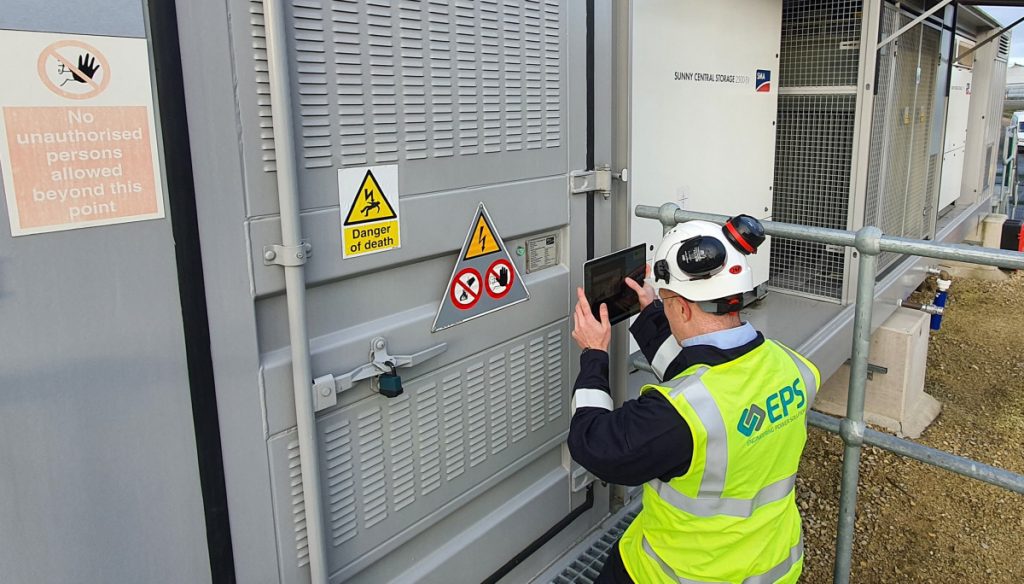Battery Energy Storage Systems (BESS) are becoming increasingly important in driving a more efficient and sustainable energy landscape in the UK. As we covered in our previous engineering article, the demand for grid-scale energy storage has risen exponentially due to the rise in renewable energy integration projects and grid stability requirements. However, with this surge in demand comes heightened safety concerns, particularly around fire hazards.
In this article, we’ll explore the fire risks in grid-scale BESS facilities in open-air environments using lithium-ion batteries (typically 1 MW or larger).
Key Takeaways
- The Battery Storage Market in 2025
- Understanding Fire Hazards in BESS Facilities
- BESS Fire Suppression Systems
- Emergency Planning for BESS Safety
- Design Considerations For Your Site

Battery Energy Storage in 2025
In 2025, BESS continues to play a key role in balancing the UK’s supply and demand of electricity. This growth has enabled a greater penetration of wind and solar power. Several factors have contributed to this, such as larger-scale installations becoming the norm and multi-megawatt projects becoming standard in grid infrastructure. The implementation of these projects has been accelerated by increased private sector investment, as energy companies and industrial users are looking to integrate storage solutions for peak shaving, backup power and grid stability.
As the BESS growth continues, fire safety remains a critical priority. It is a vital consideration that influences site design, suppression strategies, and regulatory compliance. Electrical engineers must stay ahead of these developments to design safe, efficient, and future-proof storage solutions.
Understanding Fire Hazards in BESS Installations
Lithium-ion batteries are the dominant technology in grid-scale battery storage. Despite their rise in popularity, they present several unique fire risks, with thermal runaway being one of them. This is triggered by excessive heat and causes fire to rapidly spread across assets, cascading across multiple battery cells and units. Overheating can also lead to the release of flammable gases, increasing the risk of an explosion. The residual heat and damaged cells in battery storage systems can reignite even after a fire has been suppressed.
These risks are further amplified by external threats such as wildfires, lightning strikes, and faults in the surrounding infrastructure, highlighting the need for robust fire mitigation strategies.
Real-World Incidents & Lessons Learned
A) APS McMicken Fire (Arizona, 2019)
A lithium-ion battery fire in Arizona led to an explosion, injuring four firefighters due to accumulated flammable gases igniting when the enclosure was opened. One of the key takeaways from this incident was the need for an improved off-gassing detection and a proper ventilation system to prevent the buildup of flammable gases.
Source: NFPA Report on Energy Storage System Incidents
B) Victorian Big Battery Fire (Australia, 2021)
The Victorian Big Battery (VBB) is a 300 MW BESS project in Australia and is one of the largest battery storage facilities globally. A coolant leak caused a battery module to overheat and catch fire, destroying two Megapack units. One of the significant lessons learned was the critical value of having an emergency response plan; the fire incident proceeded as planned, with no injuries, explosions, or unexpected developments. It was contained to 2 out of 212 Megapack units, caused minimal environmental impact, and did not affect the grid. Also, the operational delay was very minimal.
Source: Victorian Big Battery Fire: Report of Technical Findings, 2021
C) South Korean BESS Fires (2017-2019)
Between 2017 and 2019, 28 BESS fires occurred, temporarily halting the country’s energy storage market. It was concluded that these fires occurred due to electrical faults, poor environmental conditions. Investigations also found that there was poor surge protection and moisture ingress that contributed to these failures, underscoring the need for robust site conditions and electrical design.
Source: South Korean Battery Fire Incidents – PV Magazine, 2023
Fire Suppression Systems for Battery Storage Facilities

Water-Based Sprinkler Systems
- Sprinklers and deluge systems help to cool battery enclosures and limit fire spread.
- Water-based suppression is more effective than gas systems for preventing reignition.
- NFCC guidelines recommend on-site hydrants delivering at least 1,900 litres per minute for 2 hours.

Fire-Resistant
Barriers
- Physical barriers between BESS units can slow down fire propagation.
- A minimum spacing of 6 metres between BESS containers is advised unless alternative safety measures are in place.

Gas Venting & Explosion Protection
- BESS containers should be designed with deflagration vents to prevent explosions from trapped gases.
- Exhaust systems should maintain the environment below 25% of the Lower Explosive Limit (LEL).

Advanced Detection Systems
- Early detection is key to preventing catastrophic failures.
- Gas monitoring systems detect flammable gases and trigger ventilation.
- Thermal monitoring can alert operators to potential overheating before thermal runaway occurs.
BESS Safety: Emergency Planning
A comprehensive emergency response plan (ERP) is essential for the safety and compliance of your battery storage operations. According to the NFCC, operators should have in place ERPs that consider:
- Firefighter Access: Battery energy storage sites must have at least two access points and road networks that support emergency vehicles
- Site Signage: Hazard warning signs should be visible from at least 30 metres away. Procedures must also be in place for monitoring damaged cells post-incident to prevent re-ignition.
- Water Supply Planning: Sites should include static water tanks or hydrants. They should be positioned at least 10 metres from BESS units.
- Hazard Identification: Understanding site-specific risks (e.g., battery chemistry, system layout, and surrounding infrastructure).
Design Considerations BESS Facilities

Having an effective site design can significantly mitigate fire risks in BESS installations. Key best practices include proper spacing of battery units, adequate ventilation and cooling, robust fire suppression systems, and thoughtful layout to prevent fire spread. Site designers should incorporate these features from the outset to ensure any thermal runaway or fire event can be detected early, controlled, and isolated.
Battery Spacing & Layout
6-metre gaps should be maintained between BESS containers unless additional fire-resistant measures are implemented. Storage units should be placed at least 25 metres from any occupied building across your site. They should be positioned upwind, taking into account the prevailing wind direction, from any critical infrastructure, with clear access routes for emergency response teams.
Fire Services Access
To ensure your site is accessible to fire services, design perimeter roads with turning areas to accommodate large vehicles. It’s also best practice to provide unobstructed access to all key infrastructure, including transformers and switchgear.
Vegetation & Fire Prevention
Maintaining a 10-metre vegetation-free zone around your BESS units can reduce the risk of wildfires. Implement fire-resistant landscaping materials and regular site maintenance protocols.
Environmental Protection Measures
Firewater runoff containment systems should be considered to prevent contaminated water from entering drainage networks. Site-specific flood protection should be explored if you are situated in flood prone a flood-prone area.
System Testing and Compliance with Industry Standards
Your installations must comply with national and international safety regulations, such as:
| Standard | Description |
|---|---|
| NFPA 885 | Standard for the Installation of Stationary Energy Storage Systems. |
| BS EN 16009:2011 | Flameless explosion venting devices. |
| FM Global 5-33 | Property loss prevention guidelines for energy storage systems. |
| Local Fire Codes | Consultation with local authorities ensures compliance with UK-specific regulations. |
Further Reading: Battery Energy Storage Systems: Typical Standards
Post-Incident Planning & Risk Mitigation
A structured recovery plan is crucial in the event of an incident on-site. Continuous thermal monitoring should be conducted to detect any signs of re-ignition, ensuring safety measures can be deployed effectively and as soon as possible. Proper disposal and recycling of damaged batteries must also be carried out to prevent environmental contamination. Lastly, a comprehensive site restoration process should be implemented to remediate any contaminated soil and water, restoring the site to a safe condition.
Partner with EPS for BESS Safety Today!

At Engineering Power Solutions (EPS), we have extensive experience in the electrical design and optimisation of Battery Energy Storage. Our power system engineers deliver cost-effective solutions tailored to your project requirements to ensure safe and compliant operations. Our BESS capabilities include:
- Power System Studies
- Arc Flash Energy Calculations, Prevention, and Risk Mitigation Studies
- Grid Code Compliance & Connection Studies (11kV to 400kV)
- G99 Connection Applications
- Primary Plant Layout Design (Main Structures, Surge Arrestors, Circuit Breakers, Disconnectors, etc.)
- Secondary Engineering (Protection, Schematics, Cables, etc.)
- Electrical Earthing Modelling & Design
- Project Feasibility Studies and Risk Assessments
Let our team help you take control of your energy storage strategy with BESS design and compliance support. Contact us today to discuss your project requirements..










